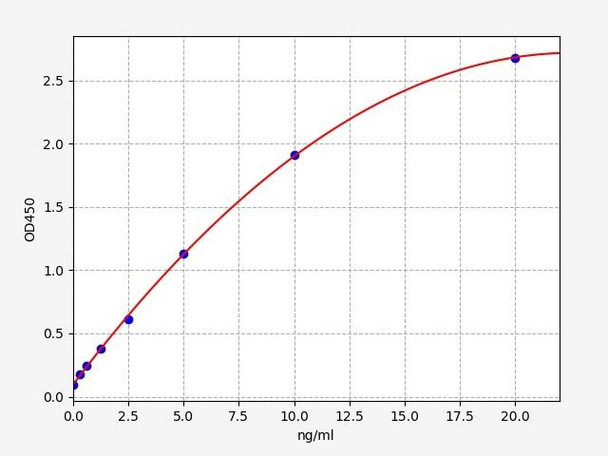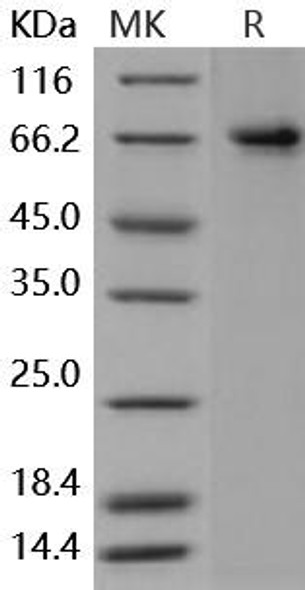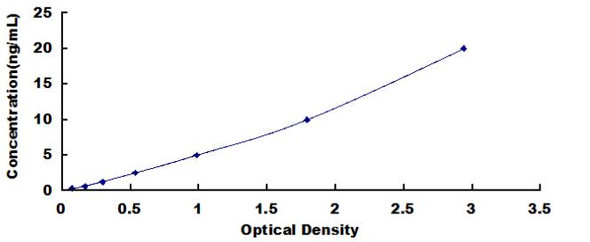Human PTGS2 / COX2 ELISA Kit (HUFI00771)
- SKU:
- HUFI00771
- Product Type:
- ELISA Kit
- Size:
- 96 Assays
- Uniprot:
- P35354
- Sensitivity:
- 0.188ng/ml
- Range:
- 0.313-20ng/ml
- ELISA Type:
- Sandwich
- Synonyms:
- PTGS2, COX-2, Prostaglandin Endoperoxide Synthase 2, PGHS-2, PHS-II, PTGS2, cyclooxygenase 2b, cyclooxygenase-2, GRIPGHS, hCox-2, PGG, HS, PGH synthase 2, PHS II, PHS-2, prostaglandin G, H synthase 2, prostaglandin G, H synthase and cyclooxygenase, P
- Reactivity:
- Human
- Research Area:
- Metabolism
Description
Human PTGS2/COX2 ELISA Kit
The Human PTGS2 (COX-2) ELISA Kit is specifically developed for the precise measurement of prostaglandin-endoperoxide synthase 2 (PTGS2), also known as cyclooxygenase-2 (COX-2), levels in human serum, plasma, and cell culture supernatants. This ELISA kit offers exceptional sensitivity and specificity, ensuring accurate and consistent results for a wide range of research applications.PTGS2/COX-2 is a key enzyme involved in the production of prostaglandins, which play a crucial role in inflammation, pain signaling, and tumorigenesis.
Dysregulation of PTGS2/COX-2 has been implicated in various diseases, including inflammatory disorders, cancer, and cardiovascular diseases, highlighting its importance as a potential therapeutic target and biomarker.By utilizing the Human PTGS2 (COX-2) ELISA Kit, researchers can gain valuable insights into the role of PTGS2/COX-2 in disease pathogenesis and progression, ultimately contributing to the development of novel treatment strategies and personalized medicine approaches.
| Product Name: | Human PTGS2 / COX2 ELISA Kit |
| Product Code: | HUFI00771 |
| Size: | 96 Assays |
| Alias: | PTGS2, COX-2, Prostaglandin Endoperoxide Synthase 2, PGHS-2, PHS-II, PTGS2, cyclooxygenase 2b, cyclooxygenase-2, GRIPGHS, hCox-2, PGG, HS, PGH synthase 2, PHS II, PHS-2, prostaglandin G, H synthase 2, prostaglandin G, H synthase and cyclooxygenase, Prostaglandin H2 synthase 2, Prostaglandin-endoperoxide synthase 2 |
| Detection method: | Sandwich ELISA, Double Antibody |
| Application: | This immunoassay kit allows for the in vitro quantitative determination of Human COX-2 concentrations in serum plasma and other biological fluids. |
| Sensitivity: | 0.188ng/ml |
| Range: | 0.313-20ng/ml |
| Storage: | 4°C for 6 months |
| Note: | For Research Use Only |
| Recovery: | Matrices listed below were spiked with certain level of Human COX-2 and the recovery rates were calculated by comparing the measured value to the expected amount of Human COX-2 in samples. | ||||||||||||||||
| |||||||||||||||||
| Linearity: | The linearity of the kit was assayed by testing samples spiked with appropriate concentration of Human COX-2 and their serial dilutions. The results were demonstrated by the percentage of calculated concentration to the expected. | ||||||||||||||||
| |||||||||||||||||
| CV(%): | Intra-Assay: CV<8% Inter-Assay: CV<10% |
| Component | Quantity | Storage |
| ELISA Microplate (Dismountable) | 8×12 strips | 4°C for 6 months |
| Lyophilized Standard | 2 | 4°C/-20°C |
| Sample/Standard Dilution Buffer | 20ml | 4°C |
| Biotin-labeled Antibody(Concentrated) | 120ul | 4°C (Protect from light) |
| Antibody Dilution Buffer | 10ml | 4°C |
| HRP-Streptavidin Conjugate(SABC) | 120ul | 4°C (Protect from light) |
| SABC Dilution Buffer | 10ml | 4°C |
| TMB Substrate | 10ml | 4°C (Protect from light) |
| Stop Solution | 10ml | 4°C |
| Wash Buffer(25X) | 30ml | 4°C |
| Plate Sealer | 5 | - |
Other materials and equipment required:
- Microplate reader with 450 nm wavelength filter
- Multichannel Pipette, Pipette, microcentrifuge tubes and disposable pipette tips
- Incubator
- Deionized or distilled water
- Absorbent paper
- Buffer resevoir
| Uniprot | P35354 |
| UniProt Protein Function: | COX-2: Mediates the formation of prostaglandins from arachidonate. May have a role as a major mediator of inflammation and/or a role for prostanoid signaling in activity-dependent plasticity. Homodimer. Belongs to the prostaglandin G/H synthase family. |
| UniProt Protein Details: | Protein type:Oxidoreductase; Lipid Metabolism - arachidonic acid; EC 1.14.99.1 Chromosomal Location of Human Ortholog: 1q25.2-q25.3 Cellular Component: endoplasmic reticulum membrane; neuron projection; protein complex; cytoplasm; caveola; nucleus Molecular Function:prostaglandin-endoperoxide synthase activity; enzyme binding; peroxidase activity; protein homodimerization activity; arachidonate 15-lipoxygenase activity; metal ion binding; heme binding; lipid binding Biological Process: positive regulation of nitric oxide biosynthetic process; positive regulation of apoptosis; response to lithium ion; positive regulation of smooth muscle cell proliferation; response to glucocorticoid stimulus; response to lipopolysaccharide; positive regulation of NF-kappaB import into nucleus; decidualization; sensory perception of pain; prostaglandin biosynthetic process; negative regulation of synaptic transmission, dopaminergic; positive regulation of synaptic transmission, glutamatergic; response to estradiol stimulus; bone mineralization; negative regulation of cell cycle; negative regulation of cell proliferation; response to vitamin D; lipoxygenase pathway; nicotinamide metabolic process; negative regulation of smooth muscle contraction; regulation of blood pressure; arachidonic acid metabolic process; positive regulation of smooth muscle contraction; angiogenesis; inflammatory response; response to fructose stimulus; water-soluble vitamin metabolic process; positive regulation of prostaglandin biosynthetic process; response to drug; negative regulation of calcium ion transport; vitamin metabolic process; cyclooxygenase pathway; positive regulation of synaptic plasticity; learning; memory; prostaglandin metabolic process; hair cycle; response to manganese ion; ovulation; NAD metabolic process; regulation of inflammatory response; positive regulation of vasoconstriction; positive regulation of fever; brown fat cell differentiation; response to oxidative stress; cell motility; embryo implantation |
| NCBI Summary: | Prostaglandin-endoperoxide synthase (PTGS), also known as cyclooxygenase, is the key enzyme in prostaglandin biosynthesis, and acts both as a dioxygenase and as a peroxidase. There are two isozymes of PTGS: a constitutive PTGS1 and an inducible PTGS2, which differ in their regulation of expression and tissue distribution. This gene encodes the inducible isozyme. It is regulated by specific stimulatory events, suggesting that it is responsible for the prostanoid biosynthesis involved in inflammation and mitogenesis. [provided by RefSeq, Feb 2009] |
| UniProt Code: | P35354 |
| NCBI GenInfo Identifier: | 3915797 |
| NCBI Gene ID: | 5743 |
| NCBI Accession: | P35354.2 |
| UniProt Secondary Accession: | P35354,Q16876, A8K802, |
| UniProt Related Accession: | P35354 |
| Molecular Weight: | |
| NCBI Full Name: | Prostaglandin G/H synthase 2 |
| NCBI Synonym Full Names: | prostaglandin-endoperoxide synthase 2 (prostaglandin G/H synthase and cyclooxygenase) |
| NCBI Official Symbol: | PTGS2 |
| NCBI Official Synonym Symbols: | COX2; COX-2; PHS-2; PGG/HS; PGHS-2; hCox-2; GRIPGHS |
| NCBI Protein Information: | prostaglandin G/H synthase 2; PHS II; PGH synthase 2; cyclooxygenase 2b; prostaglandin H2 synthase 2 |
| UniProt Protein Name: | Prostaglandin G/H synthase 2 |
| UniProt Synonym Protein Names: | Cyclooxygenase-2; COX-2; PHS II; Prostaglandin H2 synthase 2; PGH synthase 2; PGHS-2; Prostaglandin-endoperoxide synthase 2 |
| Protein Family: | Prostaglandin G/H synthase |
| UniProt Gene Name: | PTGS2 |
| UniProt Entry Name: | PGH2_HUMAN |
*Note: Protocols are specific to each batch/lot. For the correct instructions please follow the protocol included in your kit.
Before adding to wells, equilibrate the SABC working solution and TMB substrate for at least 30 min at 37°C. When diluting samples and reagents, they must be mixed completely and evenly. It is recommended to plot a standard curve for each test.
| Step | Protocol |
| 1. | Set standard, test sample and control (zero) wells on the pre-coated plate respectively, and then, record their positions. It is recommended to measure each standard and sample in duplicate. Wash plate 2 times before adding standard, sample and control (zero) wells! |
| 2. | Aliquot 0.1ml standard solutions into the standard wells. |
| 3. | Add 0.1 ml of Sample / Standard dilution buffer into the control (zero) well. |
| 4. | Add 0.1 ml of properly diluted sample ( Human serum, plasma, tissue homogenates and other biological fluids.) into test sample wells. |
| 5. | Seal the plate with a cover and incubate at 37 °C for 90 min. |
| 6. | Remove the cover and discard the plate content, clap the plate on the absorbent filter papers or other absorbent material. Do NOT let the wells completely dry at any time. Wash plate X2. |
| 7. | Add 0.1 ml of Biotin- detection antibody working solution into the above wells (standard, test sample & zero wells). Add the solution at the bottom of each well without touching the side wall. |
| 8. | Seal the plate with a cover and incubate at 37°C for 60 min. |
| 9. | Remove the cover, and wash plate 3 times with Wash buffer. Let wash buffer rest in wells for 1 min between each wash. |
| 10. | Add 0.1 ml of SABC working solution into each well, cover the plate and incubate at 37°C for 30 min. |
| 11. | Remove the cover and wash plate 5 times with Wash buffer, and each time let the wash buffer stay in the wells for 1-2 min. |
| 12. | Add 90 µl of TMB substrate into each well, cover the plate and incubate at 37°C in dark within 10-20 min. (Note: This incubation time is for reference use only, the optimal time should be determined by end user.) And the shades of blue can be seen in the first 3-4 wells (with most concentrated standard solutions), the other wells show no obvious color. |
| 13. | Add 50 µl of Stop solution into each well and mix thoroughly. The color changes into yellow immediately. |
| 14. | Read the O.D. absorbance at 450 nm in a microplate reader immediately after adding the stop solution. |
When carrying out an ELISA assay it is important to prepare your samples in order to achieve the best possible results. Below we have a list of procedures for the preparation of samples for different sample types.
| Sample Type | Protocol |
| Serum | If using serum separator tubes, allow samples to clot for 30 minutes at room temperature. Centrifuge for 10 minutes at 1,000x g. Collect the serum fraction and assay promptly or aliquot and store the samples at -80°C. Avoid multiple freeze-thaw cycles. If serum separator tubes are not being used, allow samples to clot overnight at 2-8°C. Centrifuge for 10 minutes at 1,000x g. Remove serum and assay promptly or aliquot and store the samples at -80°C. Avoid multiple freeze-thaw cycles. |
| Plasma | Collect plasma using EDTA or heparin as an anticoagulant. Centrifuge samples at 4°C for 15 mins at 1000 × g within 30 mins of collection. Collect the plasma fraction and assay promptly or aliquot and store the samples at -80°C. Avoid multiple freeze-thaw cycles. Note: Over haemolysed samples are not suitable for use with this kit. |
| Urine & Cerebrospinal Fluid | Collect the urine (mid-stream) in a sterile container, centrifuge for 20 mins at 2000-3000 rpm. Remove supernatant and assay immediately. If any precipitation is detected, repeat the centrifugation step. A similar protocol can be used for cerebrospinal fluid. |
| Cell culture supernatant | Collect the cell culture media by pipette, followed by centrifugation at 4°C for 20 mins at 1500 rpm. Collect the clear supernatant and assay immediately. |
| Cell lysates | Solubilize cells in lysis buffer and allow to sit on ice for 30 minutes. Centrifuge tubes at 14,000 x g for 5 minutes to remove insoluble material. Aliquot the supernatant into a new tube and discard the remaining whole cell extract. Quantify total protein concentration using a total protein assay. Assay immediately or aliquot and store at ≤ -20 °C. |
| Tissue homogenates | The preparation of tissue homogenates will vary depending upon tissue type. Rinse tissue with 1X PBS to remove excess blood & homogenize in 20ml of 1X PBS (including protease inhibitors) and store overnight at ≤ -20°C. Two freeze-thaw cycles are required to break the cell membranes. To further disrupt the cell membranes you can sonicate the samples. Centrifuge homogenates for 5 mins at 5000xg. Remove the supernatant and assay immediately or aliquot and store at -20°C or -80°C. |
| Tissue lysates | Rinse tissue with PBS, cut into 1-2 mm pieces, and homogenize with a tissue homogenizer in PBS. Add an equal volume of RIPA buffer containing protease inhibitors and lyse tissues at room temperature for 30 minutes with gentle agitation. Centrifuge to remove debris. Quantify total protein concentration using a total protein assay. Assay immediately or aliquot and store at ≤ -20 °C. |
| Breast Milk | Collect milk samples and centrifuge at 10,000 x g for 60 min at 4°C. Aliquot the supernatant and assay. For long term use, store samples at -80°C. Minimize freeze/thaw cycles. |






